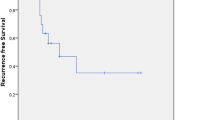Abstract
The authors report a case of usual-type (basaloid-type) vulvar intraepithelial neoplasia (VIN) 3 that failed to respond to imiquimod cream. A 51-year-old Japanese woman visited her local gynecologist complaining of vulvar itching. Atypical cells were noted in cytology smears, but nine vulvar biopsy specimens showed benign proliferation of epithelial tissue. The patient was placed under careful observation for 8 months, when the vulvar smears once again showed atypical cells and biopsy specimens revealed VIN3. The patient was then referred to our hospital where she was given a diagnosis of VIN 3, basaloid type of usual type. The biopsy specimens were positive for p16 and the lesions were confirmed to be human papilloma virus (HPV)-related. We recommended simple vulvectomy but the patient requested conservative treatment with imiquimod cream. With her written informed consent, we prescribed imiquimod cream to be self-administered 3 times a week. Colposcopy and pap smear test were performed every 2 weeks. Four weeks after the start of treatment, a fingertip-sized papule was detected at the patient’s vaginal introitus. By 6 weeks, the lesion had enlarged, and biopsy specimens revealed invasive squamous cell carcinoma. At 7 weeks, we performed simple vulvectomy. The surgical specimen showed stage pT1b keratinizing-type squamous cell carcinoma. HPV-16 DNA was detected in the specimen.





Similar content being viewed by others
References
Joura EA (2002) Epidemiology, diagnosis and treatment of vulvar intraepithelial neoplasia. Curr Opin Obstet Gynecol 14:39–43
Jones RW, Rowan DM, Stewart AW (2005) Vulvar intraepithelial neoplasia: aspects of the natural history and outcome in 405 women. Obstet Gynecol 106:1319–1326
van Seters M, van Beurden M, ten Kate FJ et al (2008) Treatment of vulvar intraepithelial neoplasia with topical imiquimod. N Engl J Med 358:1465–1473
Nader H, Christie R (1999) Frequency of invasive cancer in surgically excised vulvar lesions with intraepithelial neoplasia. Gynecol Oncol 73:119–120
Sideri M, Jones RW, Wilkinson EJ et al (2005) Squamous vulvar intraepithelial neoplasia: 2004 modified terminology, ISSVD Vulvar Oncology Subcommittee. J Reprod Med 50:807–810
Sabine R, Eduardo FN, Aida C et al (2004) p16INK4A expression as biomarker for HPV 16-related vulvar neoplasias. Hum Pathol 35:1477–1483
Annelinde T, van Seters M, Alex K et al (2010) Imiquimod-induced clearance of HPV is associated with normalization of immune cell counts in usual type vulvar intraepithelial neoplasia. Int J Cancer 127:2831–2840
Conflict of interest
The authors have no conflicts of interest to report.
Author information
Authors and Affiliations
Corresponding author
About this article
Cite this article
Shiozaki, T., Tabata, T., Toriyabe, K. et al. A case of usual (basaloid)-type vulvar intraepithelial neoplasia that failed to respond to imiquimod cream: clinical implications. Int J Clin Oncol 16, 610–612 (2011). https://doi.org/10.1007/s10147-010-0180-4
Received:
Accepted:
Published:
Issue Date:
DOI: https://doi.org/10.1007/s10147-010-0180-4




